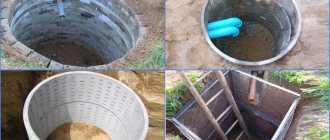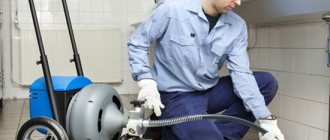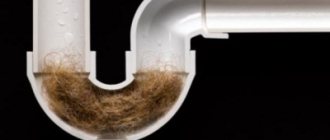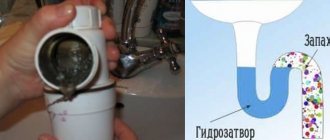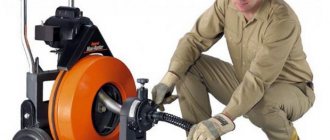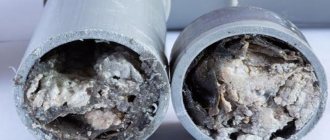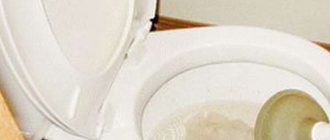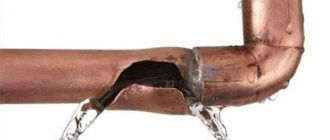What happens in apartments and in a house when a sewer riser becomes clogged depends on the design of the drainage network. Houses with different layouts may have different wiring, however, the most common layout today is the following:
- All drains (bathtub, sink, kitchen sink, washing machine and dishwasher) of one apartment are connected into a single system.
- Sometimes the toilet, washing machine and dishwasher have additional separate risers, and emergency blockages can also occur in them.
- One or more common risers are designed for all apartments located above each other.
- The common riser leads to the house's sewer well, the well leads to the main sewer system, and the main leads to the city wastewater treatment plant.
Since in one way or another the wastewater disposal system of a modern apartment building is integrated, the consequences of a clogged common building riser can affect each apartment individually and the entire building.
What are the causes of blockages?
Before clearing blockages in the sewer system, it is necessary to determine the cause of their occurrence. Moreover, there are places where they form most often, for example in the sink or in the place where the sewer pipe from the bath and kitchen goes into a common riser. And given the ability of cast iron pipes to silt up the inner diameter, the likelihood of blockage in this area is very high. The siphon in the sink often becomes dirty due to food residues draining into it. Another common problem is the presence of grease on the inner walls of the pipeline.
The cause of blockage of the riser or other communication veins may depend on the pipes used; they are of two types:
- Cast iron.
- Plastic.
In the first case, cast iron tends to collect plaque and rust inside the pipe. Corrosion causes the walls to become uneven, which encourages waste collection. Often, when dismantling them with a diameter of 110 mm, the passage was about the size of a little finger (2–3 cm).
Plastic piping is prone to clogging. In most cases, it is necessary to clean the sewer from grease due to improper installation of the route (failure to comply with the angle of inclination). A plaque appears that gradually fills the entire internal diameter of the pipe.
Mechanical sewer cleaning
Once the cause and location of the blockage have been found, you need to decide how to clean the pipes.
Pipe clogged with paper
The easiest way to remove a cork from paper is to use a water hammer. A significant increase in fluid pressure on one side will push the ball of paper through the bottleneck.
Important! This will not completely remove the plug, but will only move the clump into the riser. The paper usually becomes limp in the riser and does not cause any more problems. But sometimes it is possible to block the exit to the well or the bed. This nuisance is possible if the drain is clogged with grease, hair or other debris.
Water hammer can be created in several ways:
- With a plunger. Such a device covers the liquid in the area of discharge from the bathtub or sink. When you press the handle sharply, high pressure is created in the pipe;
- You can create a water hammer using a plastic bottle; you need to take a 1.5-2 liter container, screw the cap tightly and cut off the bottom. This device is used like a plunger;
- You can create a water hammer with a simple device made from a stick and a rag, which is folded in several layers. They place it on a surface of water at the point where the toilet flushes, and sharply press it with a stick. Don’t get carried away - too strong impacts can damage ceramic plumbing fixtures.
The last option can only be used when the toilet is clogged. A paper plug that has clogged a pipe cannot be pushed through in this way - when you press the device, the liquid will begin to flow into the bathtub or sink.
Food waste clog
It is better to clean such contamination of sewer pipes with a plumbing cable. Externally, it is an ordinary steel cable of small diameter; on one side of the cable there is a handle with which it can be rotated.
It is necessary to mention several important subtleties of using such a device:
- The cable must be inserted into the pipe under tension. If it weakens, it folds in half and forms a loop;
- It is most convenient to work with a partner; one person stretches the cable and rotates the handle, and the second person pushes it into the pipe;
- The cable should pierce the blockage several times;
- Remaining debris is removed by pouring a lot of water into the pipe.
Types of blockages
There are three varieties: Operational. A blockage forms in the sewer pipe as it is used and eventually forms deposits on the walls of various formations. Gradually they reduce the diameter of the pipe. Restoration requires thorough rinsing.
Mechanical . The problem appears when a large object, rag, etc. gets into the pipeline. To eliminate it, you must completely remove the item.
Technical .
Appears due to damage to the pipeline. Explained by the presence of a counter-angle, insufficient slope or a large number of turns. This type of congestion depends on non-compliance with installation technology.
How and with what to determine the location of the blockage?
If the sewer is clogged, you must first determine the intended location. In a private house, we will conditionally divide the entire system into two zones: the house and the street.
In the house you should pay attention to the following places:
- In the siphon under the sink in the kitchen and bathroom.
- In a corrugated pipe under the washbasin.
- At the exit of the riser to the street.
- At the connection of smaller pipes with a larger diameter.
There may be such places on the street:
- At the outlet of the pipe in the septic tank.
- On the section between the wells.
Types of cleaning at home
There are many ways to clean a drain:
- Mechanical.
- Electromechanical.
- Chemical.
- Hydrodynamic.
- Thermal.
- Pressure.
Let's consider all the features of these methods for clearing sewers when removing blockages.
Mechanical
Mechanical is carried out with a cable for punching and cleaning the sewer. There are several types of it:
- Cable.
- Tape.
- Spring-loaded.
- Spring with rod.
Cable. A standard size sewer cable has a cross-section of Ø6 mm. Made from galvanized steel. It is strong, durable, elastic, flexible. The end of the cable is specially crimped so that it does not unwind. It looks like a brush and you can wrap hair dirt around it. It is best to clean it at home when its length is up to five meters.
Tape . Flat cable for cleaning sewer pipes. The width of the tape reaches up to 40 mm. Because of this specific shape, it is difficult for them to go through a large number of turns (due to the ability to bend only in one plane).
Taking this feature into account, ribbon plumbing cable is used for punching pipes of large diameter and length, since it will definitely not twist along its course.
Spring with rod. It is used by professionals.
Mechanical cleaning of the home sewer with a spring cable allows you to remove complex and large blockages. It is based on wire and spring.
A galvanized cable located inside the spring is used as a rod.
The cable diameter ranges from 13 to 16 mm. As for the length, it reaches up to 60 m.
Spring-loaded . The cable consists of one spring.
It's hollow inside. Diameter no less than 9 mm. The cable must be equipped with a handle for its rotation. It is used for pipes of small diameter, as well as for minor blockages.
How to break through a sewer yourself with a cable?
One end of the cable should be directed into the pipe and gradually pushed through. At the same time, you need to turn the handle.
Due to this, the cable will sink further and, thanks to rotation, break up the clogged area.
Advice! Cleaning a sewer in a private home with this equipment should only be performed by two people. One turns, and the second pushes the cable in the desired direction.
To achieve the best results, this equipment is equipped with additional attachments. Their use allows you to quickly remove debris accumulation. Nozzles:
- Hook.
- Harpoon.
- Pike.
- Ruff.
- Pear-shaped drill.
- Shovel-arrow.
- Cone drill and others.
Electromechanical
Clearing the blockage can be done using electromechanical equipment. The essence of the technology is a rotating steel wire. To achieve a better result, various attachments are put on its end:
- Drilling.
- Scraper.
- Pear-shaped.
- Hook-shaped.
The choice is made based on the goal or the nature of the problem. They can crush dirt. The spiral rotates thanks to an electric motor, and this special equipment has a gearbox that feeds the wire. Cleaning large sewer networks using this method allows achieving better results, since the length can exceed 100 meters with a pipe diameter of up to 600 mm.
Let's turn to chemicals
If you don’t have time to experiment with folk remedies, then you can use specialized mixtures that are sold in any supermarket, in the household chemicals department. They are affordable and highly effective.
If the drain is completely blocked, purchase products marked “can be used in standing water”, since other options simply will not cope with severe blockages
Let's look at the most popular chemicals used by housewives to remove blockages.
Mole is an affordable solution that is well suited for combating household pollution. Pour 200-250 g into the drain and leave for 2 hours. For old plugs, the liquid can be left overnight.
After the specified time, supply water with strong pressure. If the plug cannot be removed immediately, use the product again.
Debouche is a universal liquid for eliminating mechanical and grease blockages. Directions for use: pour 500 ml of liquid into the drain and leave for 3 hours.
For severe contamination, use twice as much product, and the validity period increases to 10-12 hours. After using Debouche, be sure to rinse the pipes thoroughly with water.
Pothan is a solution for removing any types of blockages in cast iron and plastic pipes. First, you need to lower the water level in the drain by 5 cm. Next, pour 100 ml of the product and 100 ml of boiling water. After 5 minutes, warm water is supplied to the drain.
Mister Muscle is a popular powder for eliminating fat plugs. It penetrates into the most difficult places and, due to its special composition, removes not only clogs, but also harmful bacteria and unpleasant odors. According to the manufacturer, Mr. Muscle copes with the problem in just 5-10 minutes.
When using specialized cleaning products for sewer pipes, it is very important to strictly follow the instructions on the packaging. Otherwise, the active substances of the product may damage the pipeline
Floop is a cleaner that dissolves fatty, organic and hair plugs. The product is quite caustic, so when working with it, be sure to equip yourself with protective clothing, a respirator and rubber gloves.
When adding Floop to a drain hole, it is important to avoid getting it on plumbing fixtures, as well as on exposed body parts or clothing. The product is poured with hot water and left for the time specified in the instructions. Then the drain is washed generously with cold water.
Tiret Turbo is a universal solvent produced in the form of gel and granules. In the first case, it is poured into the drain and left for 5-10 minutes. Using the granular version, it is first poured into the drain, and then 500 ml of hot water is added and left for at least 10 minutes.
It is prohibited to use the latter remedy for longer than the time specified in the instructions. The active substances included in its composition can cause destruction of pipe walls.
There is an article on our website where we examined in detail the best chemicals for cleaning sewer pipes. Read on for more details.
How to clean and rinse the siphon?
A clogged siphon is considered a simple task, and even a schoolchild can get rid of it on his own.
Advice! The easiest way is to disassemble the siphon. If this is not possible or there is simply no desire to get your hands dirty, then chemical and mechanical methods are used.
Can be used for a siphon - plunger. Sharp up/down movements can push through the dirt. If it is not there, then clean the drain with vinegar and soda.
Vinegar and soda
Cleaning drains with vinegar and soda is performed in the following sequence:
- Pour a small amount of dry soda (half a pack) into the siphon through the drain hole.
- It is important that the soda does not get stuck through the protective grille. To do this, you can push it with a stick or build a funnel out of paper.
- Then pour in half a liter of vinegar.
- A hissing reaction will then occur.
- As soon as the reaction stops, pour out the boiling water.
If the result is not achieved, the procedure can be repeated.
Advice! Before you clean the sewer pipe and siphon with soda and vinegar, you need to make sure that the problem is in this place.
Lemon acid
First, citric acid is poured into the siphon hole, and then water, or preferably vinegar, is poured in. The hissing process will remove dirt very quickly.
Cleaning drains with wire
To clean the sewer system, you need a wire 5-6 mm in diameter. It is used in the same way as a cable, there are only 3 differences:
- The wire bends poorly and has difficulty penetrating pipe bends. If there is no tee or inspection, then you will have to disassemble the connection or, as a last resort, punch a temporary hole in the pipe. When the pipe is clean, cover the hole with a cut inner tube from a bicycle or a rubber bandage. A clamp is installed on top of this winding;
- The blockage must be cleared from top to bottom, otherwise several meters of accumulated wastewater will immediately pour out on you;
- You need to rotate the wire when removing it, so the hooked rag will not come off.
Human hair and animal hair are removed from the pipe using wire or cable. Hair is removed from under the outlet grill in 2 ways:
- Hooking them with a wire hook;
- Disassemble and clean the grille.
Cat litter or construction waste is removed using a wire brush or cable.
Preventing blockages
It's better to prevent the problem from happening than to figure out how to clear your sewer pipes of contaminants. Therefore, experts recommend carrying out preventive work:
- Once a month pour boiling water. Just don't pour it down the toilet, it will crack.
- Clean siphons once a month using soda and vinegar or disassemble them.
- When washing dishes, use warm water and detergents.
- Pump out wastewater from the septic tank in a timely manner.
- Use chemicals for prevention.
Sewer flushing
Sewer pipes clogged with grease can only be cleaned by rinsing them with hot water.
- If there is no gap at all in the fat layer, the cork is first pierced with wire or cable;
- Connect the flushing hose with hot water;
- Insert its tee or revision above the clogged area;
- Hot water is released into the pipe, gradually increasing the pressure.
If fat has frozen in a pipe in an apartment, you can simply run hot water into it, gradually increasing the flow until the fat plug warms up. Water heated to 80 degrees removes fat plugs in 30-60 minutes.
